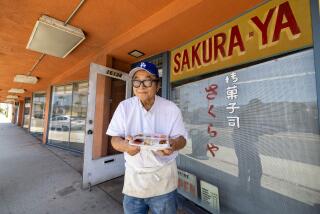JAPAN / LABOR TURMOIL : Sour Note Mars Social Harmony
TOKYO — Japan’s myth of social harmony took a devastating blow last week when rioting erupted among day laborers in the country’s largest skid row.
Once the smoke cleared over the weekend, after four days of violence in Osaka’s seedy Kamagasaki district, the monolithic Japanese media pointed a collective finger at police corruption as the cause of the rare disturbance.
The arrest of a police officer on charges of taking bribes from local yakuza gangs, news reports concluded, had triggered angry protests that led to burning, looting, 55 arrests and 186 injured. Disfranchised youths from outside the district joined the fracas, scenes of which horrified Japanese television viewers accustomed to seamless social order.
It was all said to be the fault of a single cop on the take.
But ask Father Akira Fujiwara what was behind the sudden outburst of chaos, and the story becomes a little more complex. The Roman Catholic priest, who runs a mission in Kamagasaki, said he sees a deep undercurrent of anger and resentment in Japanese society, but particularly in Kamagasaki.
“Japan is a very peaceful place for those who fit in,” Fujiwara said. “But here we have a collection of people who have been cast off by society, and there is no shortage of castoffs outside Kamagasaki. The frustration and the anger keep building.”
Kamagasaki is Japan’s largest yoseba --literally a “gathering place” where a labor market has evolved over decades to provide small contractors and manufacturers with cheap, unskilled workers. Now home to about 20,000 day laborers, the neighborhood is notorious for its cramped, filthy flophouses and its indigent homeless.
Alcoholism, gambling, drug abuse and prostitution are rampant. Rioting, too, was fairly common from the 1960s through the early 1970s, until labor unions succeeded in driving yakuza labor brokers out of the city-operated marketplace and economic stability brought calm.
City authorities have since made efforts to clean up the place, including the bureaucratic trick of renaming the district “Airin,” which means “neighborly love.” Residents ignore the new name.
The yakuza still control an unofficial labor market on the curb, and they openly run gambling stalls in the heart of the district, social workers and union officials say. The core area is spotted with surveillance video cameras, yet police look the other way when laborers and vagrants fall victim to yakuza crime, critics complain.
“The men are treated like suspects, not like human beings,” Fujiwara said. “When they get beat up and robbed, the police won’t listen to their complaints, and if they’re seriously injured they can’t even get an ambulance to take them to a hospital.”
Violence remains the exception rather than the rule in contemporary Japan, yet some recent signs suggest that self-restraint is wearing thin.
Ironically, Kamagasaki is enjoying a period of relative prosperity. Work is plentiful--but so are the yakuza .
News that Tsutomu Haga, a 38-year-old detective in the local police station, was arrested early last week for allegedly taking more than $70,000 in yakuza bribes struck a raw nerve. On Tuesday, officers stepped in to break up a routine street brawl and were soon besieged by an angry mob. Some protesters shouted about Haga.
“The ties between the police and organized crime are very clear to everyone who lives in this neighborhood,” said Kichiro Dan, a Kamagasaki Day Laborers Union official. “It’s a routine part of our daily life, and last week a lot of routine anger simply spilled out.”
More to Read
Sign up for Essential California
The most important California stories and recommendations in your inbox every morning.
You may occasionally receive promotional content from the Los Angeles Times.










